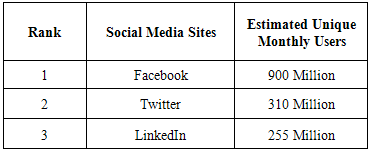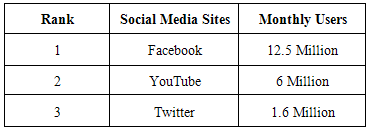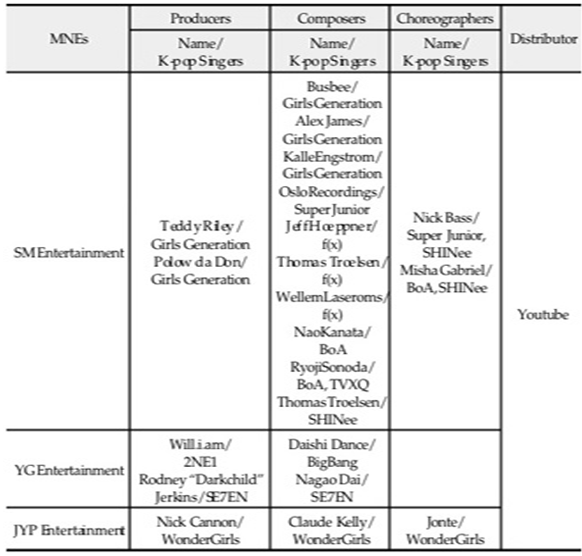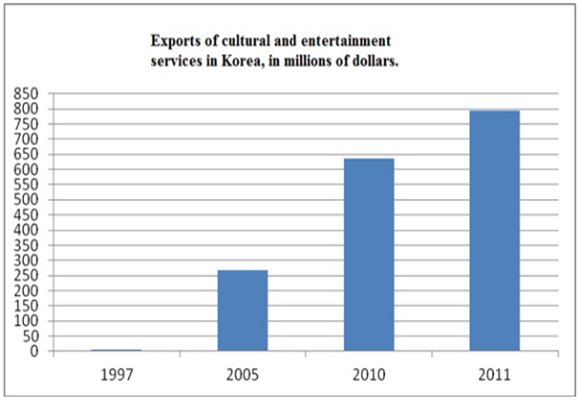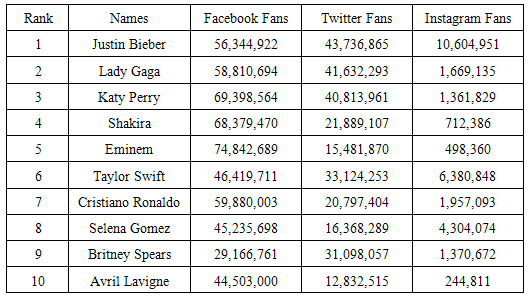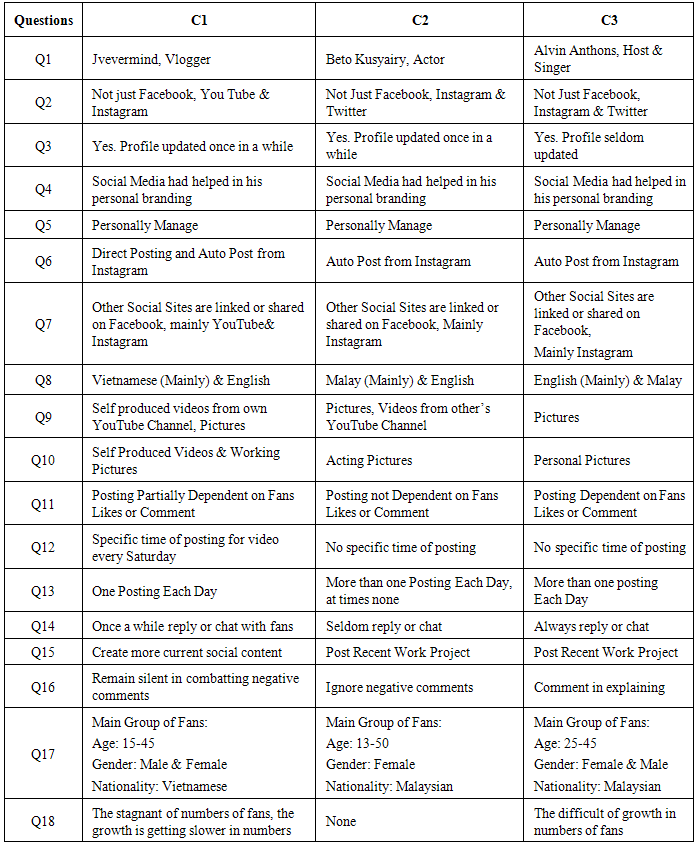-
Paper Information
- Next Paper
- Previous Paper
- Paper Submission
-
Journal Information
- About This Journal
- Editorial Board
- Current Issue
- Archive
- Author Guidelines
- Contact Us
American Journal of Economics
p-ISSN: 2166-4951 e-ISSN: 2166-496X
2015; 5(2): 236-242
doi:10.5923/c.economics.201501.30
Social Media Strategies for Personal Branding– A Case Study of Malaysian Celebrities on Facebook
Soo Wincci, Wardah Mohamad
OUM Business School, Open University Malaysia
Correspondence to: Soo Wincci, OUM Business School, Open University Malaysia.
| Email: |  |
Copyright © 2015 Scientific & Academic Publishing. All Rights Reserved.
Social media has transformed the world in many ways, changing the way we communicate, the frequency we communicate and even the time of communication. It has taken the world by storm and the world today is so much different from the world a decade ago. People from across the globe can now talk to each other at any time and business is simply a click away. We can now buy and sell things on-line and even education has been transformed, with knowledge being disseminated very easily across the globe. Social media has greatly influenced the way people to brand themselves, and the power of technology has resulted in many advances through the years. With all this affecting our lives, the effect that social media has had on the Malaysian entertainment industry has yet to be studied. This paper explores how social media strategies have been used as a personal branding and marketing tool, with special reference to the celebrities in the Malaysian entertainment industry. In the initial pilot study presented, it was found that Facebook had helped all the celebrities in building up their personal brand name. The findings also signified the importance of social media strategy, content strategy and communication with fans to gain constant following. The success of the celebrities was attributed to their authencity via personally managed pages and efficiency via mobile management and platform maximisations.
Keywords: Social media strategy, Personal branding, Facebook
Cite this paper: Soo Wincci, Wardah Mohamad, Social Media Strategies for Personal Branding– A Case Study of Malaysian Celebrities on Facebook, American Journal of Economics, Vol. 5 No. 2, 2015, pp. 236-242. doi: 10.5923/c.economics.201501.30.
Article Outline
1. Introduction
- Social media has transformed the world in many ways, changing the way we communicate, the frequency we communicate and even the time of communication. It has taken the world by storm and the world today is so much different from the world a decade ago. Social media is a breakthrough for the traditional marketing platform due to its viral growth and technology advancement. The power of technology breaks down traditional obstacles to human interaction and this enhances the growth of a new wave of human creativity (11). Mass adoption of the Internet is driving the most exciting social and cultural transformations in history.The proliferation of communication technologies has advanced at an unprecedented speed. In the first decade of the 21st century, the number of people connected to the Internet worldwide increased from 350 million to more than 2 billion. It is now over 2.4 billion. The invention of smart phones speeds up the growth of Internet and social media platforms. It is forecasted in the near future the whole world of 8 billion people on earth will be online (9).
2. Literature Review
- The global connectivity will keep growing and breaking down old institutions and traditional hierarchies. This advancement of technologies will lead us to two worlds, that is virtual (online) and physical world (operational) (6). In many ways, individual’s virtual identities on their social media platforms will supersede as the trails individuals leave will remain engraved online in perpetuity. Meaning, what one post or share online shapes one’s virtual identities. As pointed by (1) social media will become a necessity. In the future, social media will be divided into four major scopes; they are Political, Social, Corporate and Personal (9) This is indicated in Figure 1. Hence, new forms of collective responsibility and strategic strategies need to be evaluated from time to time.
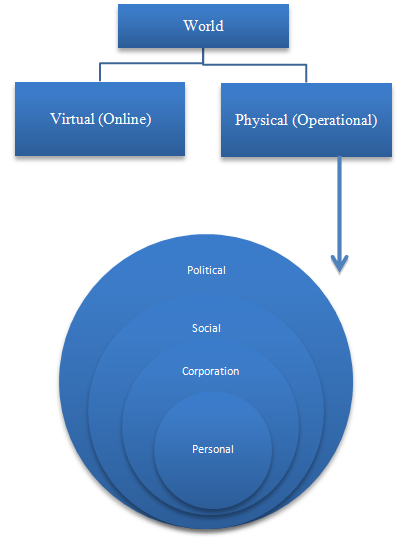 | Figure 1. Online World |
 | Figure 2. The Transformation of Media |
|
|
2.1. K Pop Globalization Social Media Strategy
- Many authorities still do not see the benefit and the effect of social media strategies, which could affect the nation revenue effectively. One of the most successful strategic examples in Asia is The Globalization Strategy of K-Pop (13), utilizing branding strategies and social media strategies K-pop export the music made in Korea to the global market via the YouTube social media platform and using differentiation strategy to attract global audience and subsequently increased the nation’s revenue. They utilized the cultural technology to train and manufacture celebrities on three fundamental steps (19):(a) Exporting cultural products by placing Korean singers in different countries.(b) Creating International Collaborations.(c) Globalizing the product by cooperating with musicians from different countries to create a global brand.After the training system, they brand their celebrities with the three fundamental strategies: (i) Numbers of members in a group, (ii) Physique and (iii) Voice-dance coordination (13). Lastly, the South Korean music industry is comparatively small, songs are released onto national television and simultaneously uploaded onto YouTube to reach out to distribute and export all their music and celebrities via social media platform (YouTube). The K-Pop Globalization Drive is shown in Table 3.As indicated in Table 3 K-pop’s Globalization Drive, The strategy developed from Political SMS (The discovery of a new way to market Korean Product in the international market with lower cost and effective results using the power of celebrity and social media), to Social SMS (The Formation of few major Entertainment Companies to create an organizational ecology), to Corporate SMS (The manufacturing of celebrities and musical inputs) to Personal SMS (The individual branding of celebrities themselves). All these strategies were united in one social media platform, which is YouTube to create the whole K-Pop Globalization Social Media Strategies. However, in this syphoning type of strategies, the corporate and companies will take the largest cut in the form of profits, whereas the celebrities gross relatively smaller share (13).
|
|
2.2. Effect of Hollywood Stardom on Social Media
- Hollywood celebrities like Kim Kardashian are being paid 5 figures in USD for every single tweet promoting a product or brand (Delo, 2013). This is because celebrities are being referred as a group of people who are in the limelight and attention of public via mass media (18). Celebrities cover a wide variety of public figures ranging from singers, actress, hosts, businessman or even politicians. The number of fans following celebrities on social media platforms signifies their success in utilising all social media tools. A recent research was conducted by the Elite Email (2013) in order to indicate the world's top 10 celebrities on popular social media platforms (7), and this is illustrated in Table 5.
|
2.3. Comparison K Pop vs. Hollywood Stardom
- Both K Pop and Hollywood Stardom achieve the same results but Hollywood Stardom strategy will be healthier for individuals and this suits Malaysia’s current situation where there are a lot of local phenomenon success celebrities on social media platform like Yuna, Lisa Surihani, Zizan Razak and more (Social Bakers, 2014). Figure 3 shows that whichever way the strategies progress, they would ultimately globalize each country on the global online world. In short, social media strategies must combine with personal branding strategies in order to create a successful personal branding on the social media sphere.
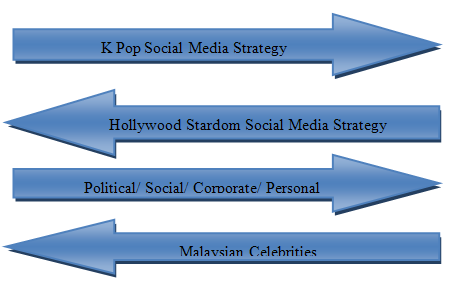 | Figure 3. Globalization of K Pop vs. Hollywood Star Systemvs. Malaysian Celebrities |
3. Research Objectives
- This study presents the findings of a pilot study done to examine the personal social media strategies adopted by celebrities on the top social media platform in Malaysia (Facebook) in building their personal branding. More specifically, it allows the examination of various approaches and new insights adopted by successful celebrities in gaining continuous success on social media platforms and methods to promote fans loyalty rather than examine firms in engaging customers.
4. Significance of Study
- Findings from the research could be used to contribute to the existing body of knowledge in local social media strategies and bridge the gap to other users or firms while providing creative and personal insights on how local celebrities utilise social media tools for branding.
5. Conceptual Framework
- The framework used in this study is shown below:
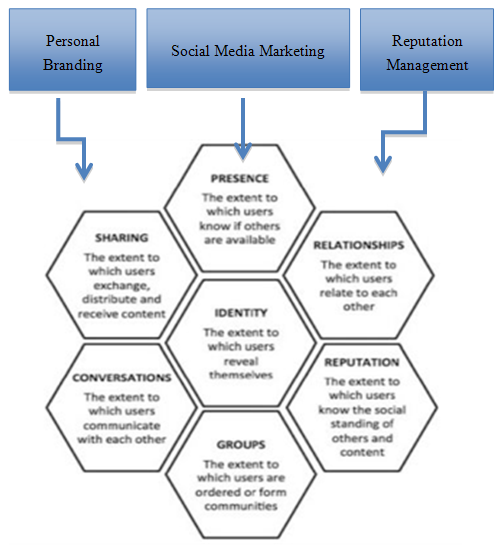 | Figure 4. Conceptual Framework: Analysis of Malaysian Celebrities’ Personal Branding via Social Media Strategy on Facebook |
6. Pilot Interview
- In order to test the reliability and validity of the framework and interview questions, a pilot test was carried out. Face to face interviews were conducted with three celebrities;C1:A Famous Vietnamese Blogger (1.9 million Facebook Fans) C2: Famous Malaysian Actor, Beto (72,212 Facebook Fans) C3: Malaysian Indian Host & singer, Alvin Anthons (15,477 Facebook Fans).18 questions were asked of them, which were all recorded. Subsequently, the interviews were transcribed and then the answers were recorded into Table 6 form for thematic analysis to be done.
|
7. Analysis and Conclusions
- All 3 celebrities utilized their Facebook Fan Page to manage their different personal branding in the entertainment line. The name used on Facebook is the same across other social media platforms to enhance consistency in brand name. The frequency of updating their profile is important to keep their profile online fresh for the fans. All the three celebrities managed their Facebook Fan Page personally without a team. Facebook had helped all three celebrities in building up their personal brand name. However, Facebook is not the only tool which all celebrities utilized. They maximized their branding platform on other social media sites like Twitter, Instagram and YouTube, due to the different social media platform’s different functionalities. All three celebrities’ shared and linked their other social media platforms to their Facebook Fan Page. All three celebrities utilize their own national language as the main language when posting on their Facebook Fan Page. All three celebrities shared different contents like pictures and videos on their Facebook Fan Page.In conclusion, the celebrities’ success has a relationship to the social media strategy which they used. These data signified the importance of social media strategy, content strategy, and communication with fans, and authencity via personally managed, efficiency via mobile management and platform maximisations. However, all celebrities faced the limitation in gaining numbers of fans when they hit the top in their line or society, the only solution they though of was to collaborate with other celebrities from other countries or post content which might suit other countries. Their huge fans base on their social media platform had generated income and traditional media news which in turn led to an increase in their popularity.
 Abstract
Abstract Reference
Reference Full-Text PDF
Full-Text PDF Full-text HTML
Full-text HTML